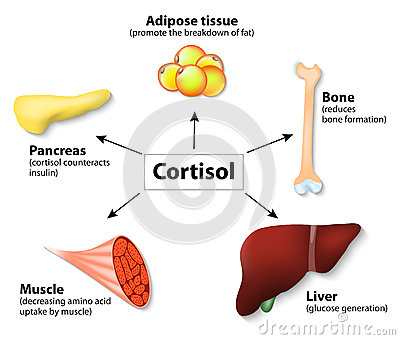Cortisol and Cycling – Muscle Demand
Cortisol is released from the adrenal gland. One of the main jobs of cortisol is to increase the glucose concentration in the blood to make more energy readily available to muscles. It increases at the onset of exercise and remains elevated throughout exercise when the muscles create a demand for energy. Cortisol helps to regulate energy by tapping into the body’s fat stores and delivering it to the working muscle and/or breaking down proteins into usable carbohydrates in the liver.
Positive Effects of Cortisol
- Regulates blood pressure, blood sugar, and insulin levels.
- Aids fat, carbohydrate, and protein metabolism.
- When you get stressed, cortisol levels spike to give you the energy and strength you need to fight or flee. It’s a survival mechanism.
- It suppresses the onset of acute inflammation if you get injured.
Natural Fluctuations
The Stress Hormone
Stress Happens
Stress also occurs from psychological, physiological, and/or physical reasons. When under stress, the body responds by increasing cortisol. Cortisol’s effects on the body are fundamentally beneficial, except when we are subjected to too much stress. Then it can become too much of a good thing.
Negative Effects of High Cortisol
An elevated cortisol level can indicate overtraining in cyclists. Too much cortisol is also associated with muscle loss and the acquisition of belly fat. High cortisol symptoms include:
- Blood pressure rises as vessels constrict
- Gastric acid production increases in the stomach
- Insulin cannot do its job of regulating blood sugar
- Blood sugar levels rise
- You crave carbohydrates and more food
- The immune system is suppressed
- The release of the DHEA hormone (Dehydroepiandrosterone) is curtailed
Bad for Muscles
High levels of cortisol can break down muscles — the catabolic effect — and is associated with a decrease in muscle growth. Thus reducing high levels of cortisol is ideal for any cyclist to achieve tissue growth and positive adaptations to exercise training.
Cortisol is Anti-Inflammatory
Pro Cycling and Low Cortisol
It Happens
Its Basic
Because some of the highest cortisol surges occur during and after exercise, endurance athletes and cyclists are exposed to more cortisol than even many of the most stressed-out non-athletes.
Good to Bad
Cortisol turns from good to bad when chronically produced in excess, such as when a cyclist over-trains. In the over-trained cyclist, high cortisol levels may have negative health effects, but even then high cortisol levels are just one of many imbalances seen in cyclists who work too hard and don’t rest enough.
Simple Advice to Control Cortisol
- Take regular, planned breaks from intense training
- Consume enough calories from non-processed foods to prevent depletion
- Consume carbohydrates and protein after exercise sessions
- Don’t isolate yourself – spend time with friends and family
- Regularly participate in a stress-relieving activity like yoga or meditation
- Avoid excessive amounts of aerobic endurance training (unless training for endurance event)
Sleep is Key
Sleep is the most important thing when it comes to reducing cortisol and restoring the adrenal glands. Work towards 7-8 hours of uninterrupted sleep between 10pm and 6am and keep a normal sleep schedule if possible.
Diet Right
Incorporate eggs, oily fish such as salmon and tuna, lean meat, flaxseed, citrus fruits, berries, fortified cereals, dark leafy greens, and create a high fiber diet with plenty of lean protein. Eating five small meals a day can help to lower your cortisol levels, relieving your body of hunger stress, and help with food cravings often associated with high levels of cortisol.
Starch and Sugar
Decreasing your starch and carbohydrate consumption can help to level cortisol. Eliminate sugar. It’s difficult to do this at first as cortisol increases your desire for sweet food and carbohydrates. When the sweet tooth hits you, satiate it with fruits.
The Average Cyclist
Cyclists typically know their bodies well, and even small changes are noticed right away. As a cyclist, you don’t need to worry too much about cortisol ruining your life. Just train smart, eat right, get enough rest, and your hormones should take care of themselves.
